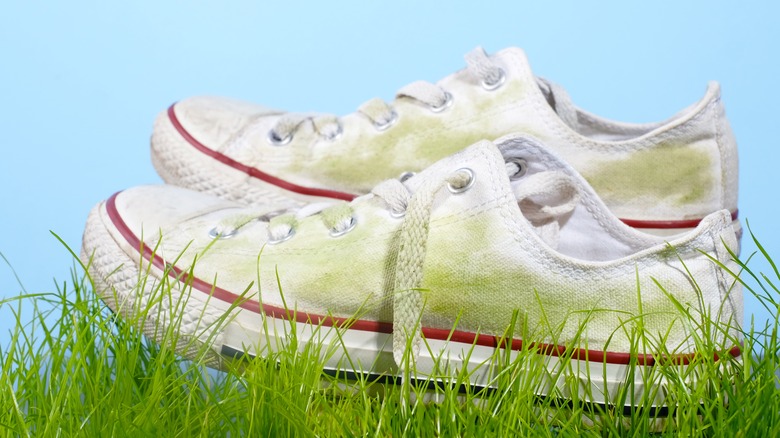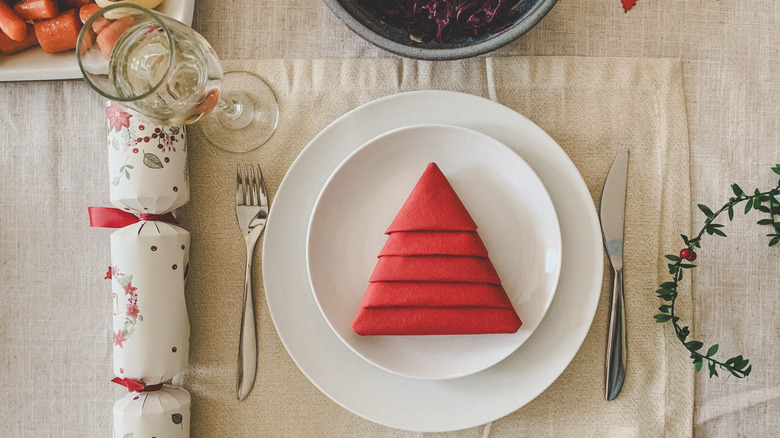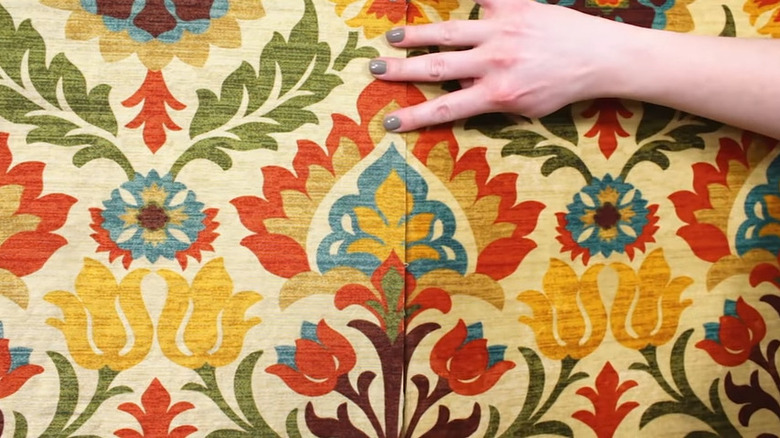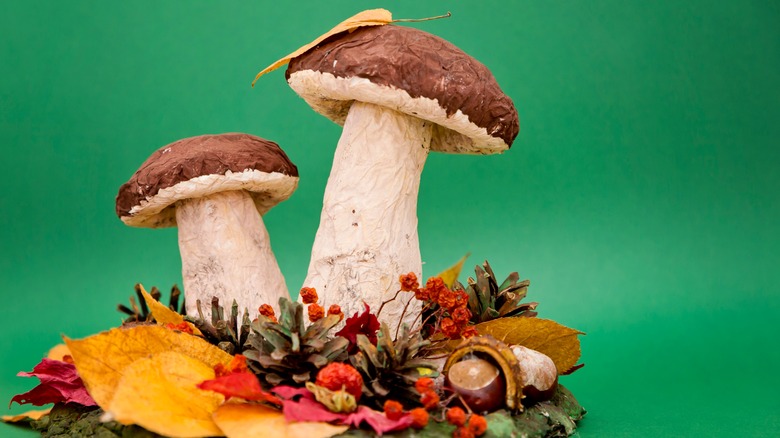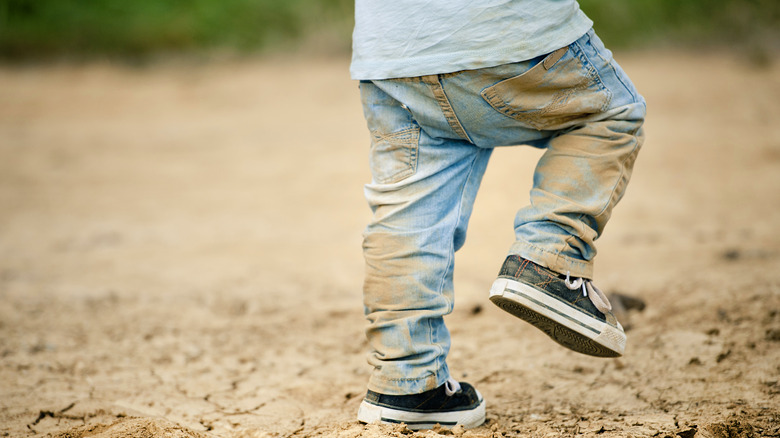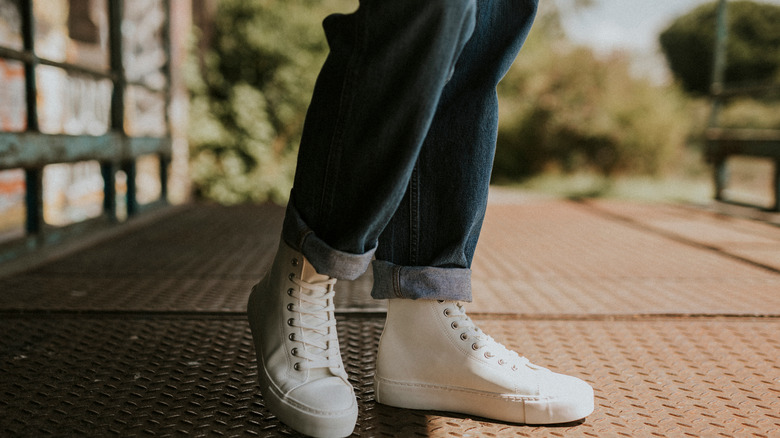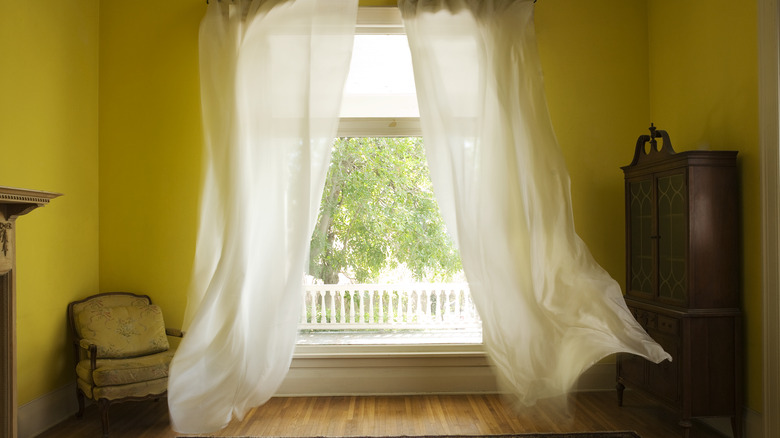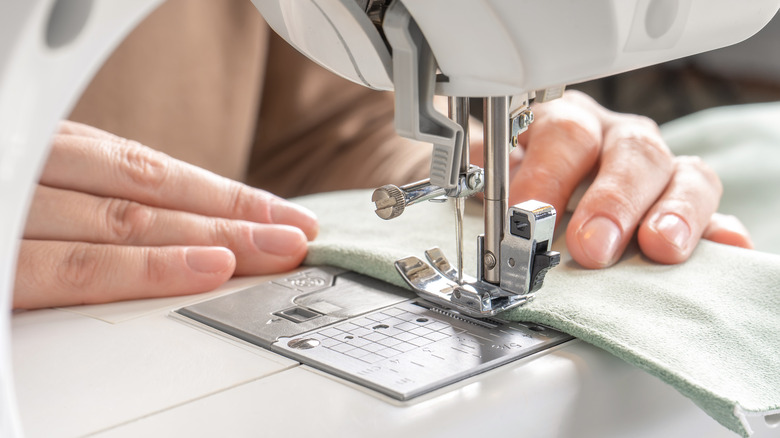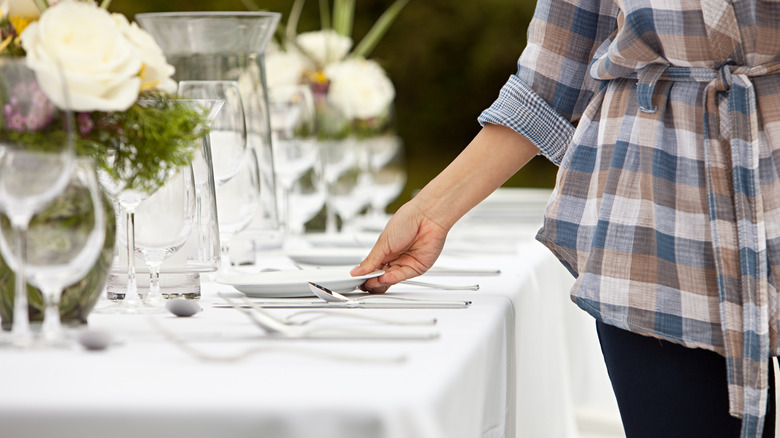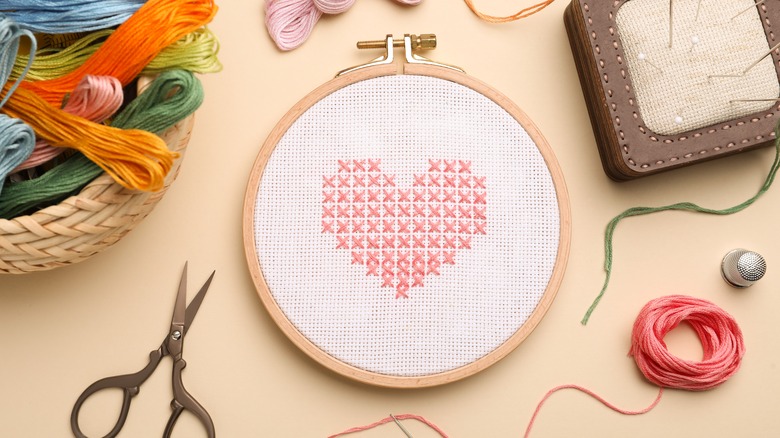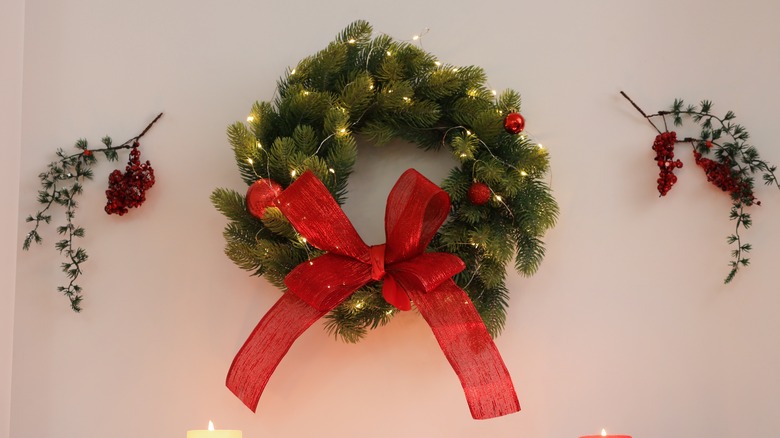12 Not-So-Obvious Things Laundry Starch Can Do
Using laundry starch when ironing your garments serves several purposes. It not only makes your clothes look crisp but can also extend the life of your clothing. It's a common product used to eliminate wrinkles, making your formal attire look that much better. But many people don't realize it has several uses that extend far beyond the laundry room. From crafting to cleaning, laundry starch is a versatile and cost-effective tool that can add to your creativity or simplify your life in ways you may not expect.
Whether you enjoy a fun DIY project, work hard to keep your home looking clean, or want a couple of hacks to make life easier, common laundry starch may be what you're looking for. Because it's an inexpensive product, using it for tasks outside of ironing clothes makes it an affordable addition for several activities. Grab a can of your favorite laundry starch and see all of the non-obvious things it can do.
Prevent shoe stains
It doesn't take much to get a brand-new pair of sneakers dirty, especially if they're white. Knowing how to clean canvas shoes is important to keep them looking their best, but what if you could repel stains to begin with? Laundry starch does this by creating a protective layer on the shoe's surface, preventing liquids from soaking into the material. This keeps fabric shoes looking fresh and clean, possibly extending their lifespan. Although this method can be effective against staining, it's not guaranteed. While there aren't any scientific studies evaluating its effectiveness, there is some anecdotal evidence of its stain-prevention abilities. It's still best to avoid stepping in puddles or spilling liquids on your shoes when possible.
To use this method to prevent shoe stains, you'll need a clean cloth and a can of aerosol laundry starch. Start by giving your shoes a good cleaning, as any dirt or moisture can inhibit the starch's ability to properly adhere to the shoe's surface. Once your sneakers are dry, hold the can about 6 inches away and apply a light, even coat of laundry starch over the entire surface. Wait 10 to 15 minutes for it to dry completely. Take a clean cloth and gently buff the shoe to remove any excess starch.
Keep your decoratively folded napkins in place
There are a few ways you can take your tablescape from average to extravagant, and decoratively folded napkins are one of the best ways to do so. That said, the last thing you want is to fold the cloth only for it to go limp the second you set it down. This is where laundry starch comes in. In the same way it adds a crispness to clothing, it'll work to stiffen fabric products. Laundry starch firms the fabric, allowing it to hold its shape better and avoid losing its decorative form. Use this hack for your next special occasion to help maintain a neat and tidy appearance throughout the meal.
To prepare your napkins for your next event, ensure they're freshly clean and dry. Lay the fabric flat, and hold a can of aerosol laundry starch approximately 6 inches away. Spray a light, even coat over the entirety of the cloth. Allow it to dry completely. Go over it with an iron to remove any wrinkles. Once the napkin is smooth and crisp, you can fold it into your desired shape, and it should maintain its crinkle-free appearance well.
Use as a temporary fabric adhesive for walls
If you want to shake things up and give your walls a splash of color or decoration without making any permanent changes, laundry starch can help you get it done. This method works because the starch starts as a sticky paste, latching onto the wall and drying into place. There are some rules to this trick, however. Certain walls may make a better surface for specific materials. For this décor idea, it's also best to use lightweight fabrics that won't fall as easily. Either way, this design technique is just for short-term switch-ups.
Start by cleaning your walls, removing all dust and moisture. You should soak your fabric in liquid starch or liberally spray it with aerosol starch rather than applying the starch to the wall. You're bound to get messy, so have a pair of gloves ready to go. You'll likely need an extra set of hands to hold the material on the wall, though you can also cut it into smaller, easier-to-work-with panels. Once the fabric is ready, apply it similarly to how you would regular wallpaper. Start at one top corner and carefully work your way across and down. Use a sponge to remove any bubbles that pop up. Allow it to dry completely, and enjoy the new décor! Once you're ready to remove it, all you'll need to do is dampen it with warm water and peel it off.
Create 3-D paper crafts
Paper crafts aren't just for children, though your kids will love this art project too. You can make some pretty neat designs using only paper, liquid starch, and acrylic finishing spray. If all you have is regular white paper, you may also want to grab a few paint colors and paintbrushes to add a design. Rather than using glue to hold this craft together, the starch will absorb into the paper, giving it plenty of stickiness to grab onto other strips. Then, once dry, the paper will harden, allowing it to hold its 3-D structure.
Grab the paper you want to shape and a bowl of liquid laundry starch. Dip the paper in the container and let it fully soak into the strips. You can also add a bit of cornstarch to thicken it to your liking. Now, it's time to take the strips out and shape the paper into whatever design you like — whether it be a colorful flower, a whimsical mushroom, or anything else your heart desires. Once dry, you can either paint over it or leave it as is. Cover the entire surface with acrylic finishing spray to add longevity to your project.
Keep kids' clothes from staining
As any parent knows, children can be messy whether they're inside or outside having fun. Whether you want to prevent as many dirt and grass stains as possible, or you want to keep them from getting their clothes dirty while eating, laundry starch can help. It not only works well to eliminate spots from popping up on clothes in the first place but can also make stains easier to clean. Rather than the gunk seeping into the fabric, the particles are instead absorbed by the starch. This isn't a foolproof method and may not work on every type of material or every type of stain. However, if you already have laundry starch laying around, it may be worth giving it a try.
One method is to put only the clothes you want starched into the washing machine and let it run as usual. Once the cycle finishes, set it to the final rinse option. Mix in the proper amount of starch according to the manufacturer's instructions and add it as you would detergent. Run the rinse cycle and air dry the starched clothing, keeping it as smooth as possible to avoid wrinkles. You can also take clean clothes and submerge them into liquid starch. Wring out any excess liquid and hang them to dry, giving plenty of time for the starch to harden and form a protective layer. Once they finish drying, you can either give the clothes to your kids to throw on or iron them to remove any remaining creases.
Make your cuffed jeans stay put
Cuffed jeans may not always be in style, but they're useful if you want to avoid dragging your hems along the ground. Unfortunately, the movement of walking can make the cuffs fall out of place. Luckily, laundry starch does more for clothing than make ironing easier; it can also hold fabric folds in place. All you need is a little starch for your cuffed jeans (or shirts) to keep them looking fabulous all day. This method will work best on soft denim, so you'll need to test it first to ensure it's right for your clothing.
If you wash your jeans with starch in the wash cycle, make sure you're allowing the pants to air dry afterward. However, the trick to keeping the folds looking crisp and fresh is an iron. Once the jeans are dry, fold the bottoms to your desired length. Run the iron over the cuffed area to allow the heat to keep them in place. No matter what activities you have planned for the day, this extra step should keep your jeans held in style for your entire outing.
Eliminate curtain creases
Curtains are a big focal point of nearly any room, especially those with bright colors or beautifully patterned designs. Because they take up so much space and draw the eye, you want your drapery to look as fresh and crisp as possible. Laundry starch can be a game-changer in eliminating creases in your curtains. Like it does with clothes, starch works by stiffening the fabric and making ironing easier, allowing you to have a professionally cleaned look right at home. Before you try this method, make sure your curtains are an appropriate fabric for using laundry starch and heat.
Start by cleaning your curtains as you typically would. When they're clean and dry, prepare your liquid starch solution according to the instructions on the package. Submerge the drapery into the mixture, allowing it to soak for about two minutes. Afterward, toss them into your dryer for a short cycle to remove any excess liquid. You can either let them air dry or dry them on your usual dryer setting required for the material. Take them out and go over them with an iron, paying attention to any spots with any persistent wrinkles. Hang them up, and enjoy your beautiful, revived window coverings.
Simplifies the process of sewing projects
When starching your clothing, don't forget to add in fabrics you use for sewing projects. Piecing together materials to create blankets and clothing can be a bit challenging, but laundry starch can make it simpler. By stiffening the fabric, you can more easily cut and sew everything together. This is especially beneficial when using lightweight or slippery fabrics that can be difficult to handle. By adding in this small extra step, your projects will look even more professional with crisp seams and a polished finish. Additionally, it can make your work more durable, as the starch can help reduce fraying and wear.
You have two options for applying the starch. Either use a spray bottle on the fabric before you iron, or dip it into a starch solution. No matter which product you have on hand, you'll have a stiff fabric that's easier to cut and piece together. While some quilters swear by this method, others think it's best to avoid it. Starching can increase the risk of scorching your hard work if you slip up with an iron. Starch can also attract pests like silverfish, so if you plan on taking your time finishing the project, it may not be ideal for storage. If you're unsure, test it out on a couple of scrap pieces and see if it's beneficial for your sewing needs.
Make cleaning table linens a breeze
If it's your turn to host holiday events this year or just want to surprise your family with a beautiful tablescape, you'll want your linens to look as good as possible. Additionally, there's always a chance that food and drinks will spill on your table linens, so you'll also want an easy cleanup method. Thankfully, laundry starch can help tackle both those issues. As it does with other fabrics, starch can add a protective layer over the linens, making them more resistant to stains and spills. They'll also be easier to clean once the gathering is over.
First, wash your tablecloth in your washing machine, ensuring you use the proper setting for the material. Fill a spray bottle with liquid laundry starch, and spray the linen thoroughly, covering all areas. Allow it to dry for a few minutes, and iron when it's still slightly damp. The heat will help to activate the starch, causing it to bond with the fabric and create that protective coating. Let linens dry completely before using them.
Shape a hat brim
As you can see, laundry starch is a versatile item. You can also use it to fix your hat brims, restoring them to their original shape. Similarly to the way it works on your shirts and jeans, starch stiffens the hat's fabric. Not only does this improve the hat's appearance, but the better fit can make it more comfortable to wear. Avoid using laundry starch on a felt-brimmed hat, as it'll leave an unsightly dusting behind.
All you'll need is the hat you want to shape, a spray bottle filled with laundry starch, and a towel. Take your towel and roll it into a circle that's the size of your hat's brim. Set the hat down in a well-ventilated area, and spray three even coats over the top. Allow it to dry for about 10 seconds before flipping it over and doing the same to the interior. Place the balled towel underneath the brim, and mold it into your desired shape. Once dry, it'll be ready to wear and hold its shape the way you like it.
Pretreat fabrics before embroidering
Embroidery can be a relaxing hobby — that is, until the thread pulls and puckers, and becomes difficult to work with. Thankfully, a little bit of laundry starch can do the trick to make the process a bit easier and make the end results look more seamless. While it's not a replacement for a stabilizer, it does make the fabric a bit stiffer and aids in making the thread pucker less. Although there isn't any substantial proof that laundry starch will work for embroidery projects, some crafters swear by this method.
Wash and dry your embroidery fabrics to remove any dirt and oils that may interfere with the laundry starch. Once dry, spray a light layer of starch over the area you plan to embroider. Iron the starched area on the proper heat setting for the type of fabric. Once it's dry, it's ready for you to add your designs. You can also opt to wash the fabric in the washing machine as you would with other starched clothing. It's a good idea to test a small piece of material first to ensure it's suitable for this method.
Hold decorative ribbons and bows in place
Ribbons are a stunning and inexpensive way to add a bit of flair to your holiday décor, whether you find clever ways to use them on your Christmas tree or wrapped presents. The only downside to crafting big, beautiful bows is they tend to droop and struggle to hold their shape. Surprisingly, laundry starch is an effective tool to combat this issue and keep your decorative bows in place for longer. You only need a spray bottle of laundry starch, your favorite ribbons, and a place to let them dry.
Cover your designated area with newspaper to avoid damage from overspray. Tie your bows or style the ribbons in the shape you want. Using a bit of tissue paper in certain areas can help it hold its shape. Once you're happy with how they look, lightly spray them with the laundry starch, being sure not to miss any sides. You don't want to soak them, however. Adjust any droopy areas as needed before letting the ribbons dry completely. For added security, spray again an hour or so later. Again, wait for your bows to dry before moving them.

